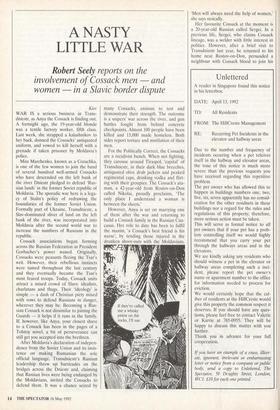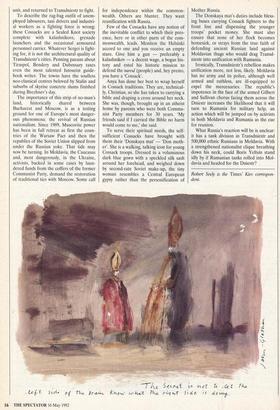A NASTY LITTLE WAR
Robert Seely reports on the
involvement of Cossack men — and women — in a Slavic border dispute
Kiev
WAR IS a serious business in Trans- dniestr, as Anya the Cossack is finding out. A fortnight ago, the 19-year-old blonde was a textile factory worker, fifth class. Last week, she strapped a kalashnikov to her back, donned the Cossacks' antiquated uniform, and vowed to kill herself with a grenade if taken prisoner by Moldavia's police.
Miss Marchenko, known as a Cozachka, is one of the few women to join the band of several hundred well-armed Cossacks who have descended on the left bank of the river Dniestr pledged to defend 'Rus- sian lands' in the former Soviet republic of Moldavia. The sporadic war here is a lega- cy of Stalin's policy of redrawing the boundaries of the former Soviet Union. Formally part of Ukraine, Transdniestr, a Slav-dominated sliver of land on the left bank of the river, was incorporated into Moldavia after the second world war to increase the numbers of Russians in the republic.
Cossack associations began forming across the Russian Federation as President Gorbachev's power waned. Originally, Cossacks were peasants fleeing the Tsar's writ. However, their rebellious instincts were tamed throughout the last century and they eventually became the Tsar's most feared troops. Today, Cossack units attract a mixed crowd of Slays: idealists, charlatans and thugs. Their 'ideology' is simple — a dash of Christian piety mixed with vows to defend Russians in danger, wherever they may be. Becoming a Rus- sian Cossack is not dissimilar to joining the Guards — it helps if it runs in the family. If, however, like Anya, your closest shave to a Cossack has been in the pages of a Tolstoy novel, a bit of perseverance can still get you accepted into the brethren.
After Moldavia's declaration of indepen- dence from the Soviet Union and its insis- tence on making Rumanian the sole official language, Transdniestr's Russian leadership threw up barricades on the bridges across the Dniestr and, claiming that Russian lives were being endanged by the Moldavians, invited the Cossacks to defend them. It was a chance seized by many Cossacks, anxious to test and demonstrate their strength. The outcome is a snipers' war across the river, and gun battles fought from behind concrete checkpoints. Almost 100 people have been killed and 15,000 made homeless. Both sides report torture and mutilation of their men.
For the Politically Correct, the Cossacks are a recidivist bunch. When not fighting, they carouse around Tiraspol, 'capital' of Transdniestr, in their dark blue breeches, antiquated olive drab jackets and peaked regimental caps, drinking vodka and flirt- ing with their groupies. The Cossack's ata- man, a 42-year-old from Rostov-on-Don called Nikolai, proudly proclaims, 'The only place I understand a woman is between the sheets.'
However, Anya is set on marrying one of them after the war and returning to build a Cossack family in the Russian Cau- casus. Her role to date has been to fulfil the maxim, 'a Cossack's best friend is his nurse', by tending those injured in the drunken shoot-outs with the Moldavians. 'Men will always need the help of women,' the says stoically.
Her favourite Cossack at the moment is it 20-year-old Russian called Sergei. In a previous life, Sergei, who claims Cossack lineage, was a welder with little interest in politics. However, after a brief visit to Transdniestr last year, he returned to his home near Rostov-on-Don, persuaded a neighbour with Cossack blood to join his
unit, and returned to Transdniestr to fight.
To describe the rag-bag outfit of unem- ployed labourers, taxi drivers and industri- al workers as a fighting force is wrong: these Cossacks are a Sealed Knot society complete with kalashnikovs, grenade launchers and the occasional armoured personnel carrier. Whatever Sergei is fight- ing for, it is not the architectural quality of Transdniestr's cities. Penning paeans about Tiraspol, Bendery and Dubossary taxes even the most talented Intourist guide- book writer. The towns have the soulless neo-classical centres beloved by Stalin and suburbs of skyrise concrete slums finished during Brezhnev's day.
The importance of this strip of no-man's land, historically shared between Bucharest and Moscow, is as a testing ground for one of Europe's most danger- ous phenomena: the revival ' of Russian nationalism. Since 1989, Muscovite power has been in full retreat as first the coun- tries of the Warsaw Pact and then the republics of the Soviet Union slipped from under the Russian yoke. That tide may now be turning. In Moldavia, the Caucasus and, most dangerously, in the Ukraine, activists, backed in some cases by laun- dered funds from the coffers of the former Communist Party, demand the restoration of traditional ties with Moscow. Some call for independence within the common- wealth. Others are blunter. They want reunification with Russia.
Few of the Cossacks have any notion of the inevitable conflict to which their pres- ence, here or in other parts of the com- monwealth, leads. Mention the Helsinki accord to one and you receive an empty stare. Give him a gun — preferably a kalashnikov — a decent wage, a bogus his- tory and extol his historic mission to defend the narod (people) and, hey presto, you have a 'Cossack'.
Anya has done her best to wrap herself in Cossack traditions. They are, technical- ly, Christian, so she has taken to carrying a bible and draping a cross around her neck. She was, though, brought up in an atheist home by parents who were both Commu- nist Party members for 30 years. 'My friends said if I carried the Bible no harm would come to me,' she said.
To serve their spiritual needs, the self- sufficient Cossacks have brought with them their `Donskaya mat' — Don moth- er'. She is a walking, talking icon for young Cossack troops. Dressed in a voluminous dark blue gown with a speckled silk sash around her forehead, and weighed down by second-rate Soviet make-up, the tiny woman resembles a Central European gypsy rather than the personification of Mother Russia.
The Donskaya mat's duties include bless- ing buses carrying Cossack fighters to the front line and dispensing the younger troops' pocket money. She must also ensure that none of her flock becomes homesick, or strays from the true faith of defending ancient Russian land against Moldavian thugs who would drag Transd- niestr into unification with Rumania.
Ironically, Transdniestr's rebellion makes unification more, not less, likely. Moldavia has no army and its police, although well armed and ruthless, are ill-equipped to expel the mercenaries. The republic's impotence in the face of the armed Gilbert and Sullivan chorus facing them across the Dniestr increases the likelihood that it will turn to Rumania for military help, an action which will be jumped on by activists in both Moldavia and Rumania as the cue for reunion.
What Russia's reaction will be is unclear: it has a tank division in Transdniestr and 500,000 ethnic Russians in Moldavia. With a strengthened nationalist clique breathing down his neck, could Boris Yeltsin stand idly by if Rumanian tanks rolled into Mol- davia and headed for the Dniestr?
Robert Seely is the Times' Kiev correspon- dent.



















































 Previous page
Previous page